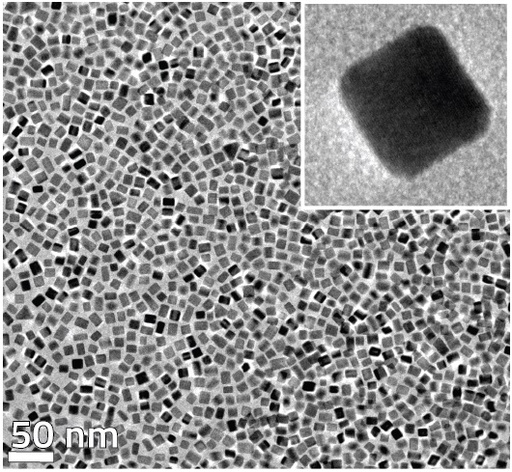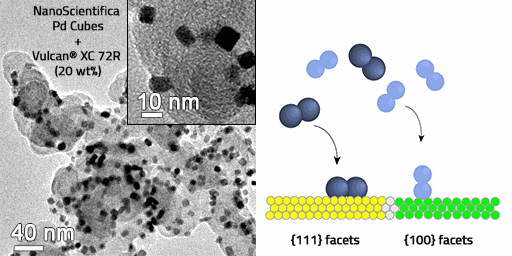NSS Palladium Cubes
CAS number: 7440-05-3 | EC number: 231-115-6

Our unique technology provides an ideal toolkit for the realization of novel and more efficient catalysts, which is valuable to the industry. Our overall goal is to bring shaped Platinum Group Metals, PGM, (platinum, palladium, rhodium, iridium, ruthenium, and osmium)
Nanoparticles to the catalyst market, automotive emission control (which accounts to 65 % of the gross world demand of platinum and palladium), catalysis of chemicals (e.g., pharmaceutical compounds) conducted in liquid and gas phase, and future fuel cell technologies.
Structural features
By decreasing the size of metal particles down to the nanoscale, more atoms are exposed to the crystalline facets (larger surface area) encompassed by local rearrangement of the atoms in restrained geometrical space. This entanglement between the size and shape of metal nanocrystal governs, for instance, their catalytic performance. PGM nanoparticles enclosed by specific facets abruptly enhance the catalytic activity of chemical processes in liquid or vapor phases and improve the product selectivity in comparison to particles having the same or smaller sizes but with indistinct shape.
For instance, Pd nanocubes enclosed by {100} facets have shown greater catalytic activity for formic oxidation, oxygen reduction, pyrrole hydrogenation, and Suzuki coupling. NanoScientifica Pd Cubes contains >98% {100} facets and can be easily combined with high surface area metallic oxide or carbon-based microparticles and exploited as a catalyst for the synthesis of pharmaceutical compounds, fuel cells, hydrogen sensing, and storage, etc. Our standard solution is to ship the particles in an aqueous solution, please inquire about other solvents or solid support.
| Product number | NSSPdNC10 |
NSSPdNC30
|
NSSPdNC50
|
| Appearance | Black suspension | Black suspension | Black suspension |
| Average size | 10 nm | 30 nm | 50 nm |
| Concentration | Contact us |
Contact us
|
Contact us
|

Scarce metals
Resource scarcity is one of the most critical global challenges. Based on their crustal concentrations in mineable deposits, PGMs are scarce and much less productive than those comprising more common metals. PGMs are valued for their myriad industrial applications including the manufacture of automotive catalytic converters and hydrogen production (e.g. fuel cells).
Current state-of-the-art Platinum Group catalysts are mostly built on poor shape and size control small nanoparticles, which usually provide poor reaction selectivity and limited performance. More strict emission control policies and increasing demand for cleaner energy platforms are imposing pressure on the use of catalysts with higher loadings of PGM materials.
As a thumb rule, the greater the geological scarcity of the mineral, the earlier the price increase will start while exhaustively consumed. NanoScientifica Scandinavia is proud to empower the PGM catalyst market by the large-scale distribution of competitive morphology-controlled nanocatalysts.

Core advantages
In the scientific literature, it is well established that small and geometrically controlled nanocatalyst shows a higher catalytic performance when compared with particles attaining indistinct shape. NanoScientifica Scandinavia is fully engaged into maximize resource utilization of scarce PGM materials by enabling the production of highly catalytic materials. Our utmost target is the fabrication of industrial nanocatalyst coming 100% from recycled metal sources in the next 2 years.
